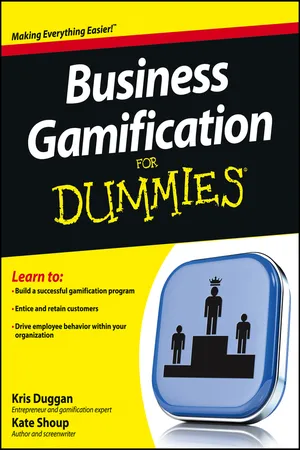
eBook - ePub
Business Gamification For Dummies
Kris Duggan, Kate Shoup
This is a test
Share book
- English
- ePUB (mobile friendly)
- Available on iOS & Android
eBook - ePub
Business Gamification For Dummies
Kris Duggan, Kate Shoup
Book details
Book preview
Table of contents
Citations
About This Book
The easy way to grasp and use gamification concepts in business
Gamification is a modern business strategy that leverages principles from games to influence favorable customer behavior on the web in order to improve customer loyalty, engagement, and retention. Gamification can be used by any department in a company (HR, Sales, Marketing, Engineering, Support, etc.), for any web-based experience (mobile, website, retail, community, etc.).
Business Gamification For Dummies explains how you can apply the principles of this strategic concept to your own business model.
- How gamification evolved from Farmville/Zynga and Facebook and is now something that can be applied to the work environment
- How to build a successful gamification program
- How to entice and retain customers using gamification
- How to drive employee behavior inside your organization
- Real-world illustrations of gamification at work
If you're interested in learning more about this exciting and innovative business strategy, this friendly, down-to-earth guide has you covered.
Frequently asked questions
How do I cancel my subscription?
Can/how do I download books?
At the moment all of our mobile-responsive ePub books are available to download via the app. Most of our PDFs are also available to download and we're working on making the final remaining ones downloadable now. Learn more here.
What is the difference between the pricing plans?
Both plans give you full access to the library and all of Perlego’s features. The only differences are the price and subscription period: With the annual plan you’ll save around 30% compared to 12 months on the monthly plan.
What is Perlego?
We are an online textbook subscription service, where you can get access to an entire online library for less than the price of a single book per month. With over 1 million books across 1000+ topics, we’ve got you covered! Learn more here.
Do you support text-to-speech?
Look out for the read-aloud symbol on your next book to see if you can listen to it. The read-aloud tool reads text aloud for you, highlighting the text as it is being read. You can pause it, speed it up and slow it down. Learn more here.
Is Business Gamification For Dummies an online PDF/ePUB?
Yes, you can access Business Gamification For Dummies by Kris Duggan, Kate Shoup in PDF and/or ePUB format, as well as other popular books in Business & Consumer Behaviour. We have over one million books available in our catalogue for you to explore.
Information
Part I
Basic Training: Grasping the Basics

In this part . . .
As you embark on your gamification education, it’s easy to get overwhelmed. This part is devoted to helping you stave off any gamification-related anxiety. In addition to discovering what all the fuss is about, you’ll find out just what makes your users tick and consider what business objectives you want to achieve through gamification. We help you determine what types of behaviors might drive those objectives, and you’ll explore the various types of rewards available for your program. Finally, you’ll survey the game mechanics common in many programs. With these basics under your belt, you’ll be primed to use gamification to its fullest potential.
Chapter 1
Gamifi-wha? Introducing Gamification
In This Chapter




Gamification. Say the word, and chances are the response will be, “Gamifi-wha?” It’s not even in the dictionary — meaning, ironically, that you can’t use it in a game of Words with Friends.
The fact is, the term just hasn’t made it to the mainstream vernacular — although we’re confident it soon will. Before August 2010, almost no one searched for the term gamification on Google. Starting in January 2011, however, searches have spiked. And according to Gartner, Inc., by 2014, more than 70 percent of Global 2000 organizations will have at least one gamified application. Some experts project that the gamification market will grow to $2.8 billion by 2016!
In this chapter, you’ll find out what gamification is, how it works, and who’s using it. You’ll also discover the basic steps involved in launching a gamification program.
Paging Mr. Webster: Defining Gamification
So what does gamification mean? Simply put, gamification refers to the use of game mechanics and rewards in a non-game setting to increase user engagement and drive desired user behaviors. (You’ll learn all about rewards in Chapter 5, and game mechanics in Chapter 6.) You can use gamification to increase such things as stickiness, sharing, content creation, purchases, and so on.
Best behavior
In part, the idea behind gamification is to tap into people’s innate desire to play games to influence how they behave and what they do. (This innate desire explains why games are big business. In 2010 alone, digital games generated $25 billion in sales.) It’s about making things fun — something that game makers have known for decades, but that the rest of us are just figuring out.
More than that, though, gamification is about tapping into what really motivates people and then using a variety of techniques (discussed throughout the book) to inspire them to perform desired behaviors. As an added bonus, with gamification, the desired behaviors that users perform are recordable — and when you have data, you have an opportunity to act on it.
Sound creepy? Fair point well made. Yes, gamification can certainly be used to promote behaviors in which people might not otherwise engage. But the best gamification programs operate by rewarding people for behaviors they are already inclined to perform or are required to perform, increasing their engagement and enjoyment. In other words, gamification makes things more fun.
If you’re feeling skeptical, consider this: If you’ve tucked a frequent shopper card in your wallet in the hopes of someday getting one free sub, purchased a plane ticket using airline miles, been Employee of the Month, or earned your black belt in karate, you’ve already seen the effects of gamification. All those are real-world examples of gamification in action. Honestly, if you think about it, this type of gamification is everywhere — and it has been for a while. What’s new is that gamification is now being applied to websites and software applications. That’s the kind we focus on in this book.
To be clear, gamification isn’t about creating a game. Don’t get us wrong — games are great. But slapping a game on your site probably won’t help you attract more users. Rather, with gamification, you use game mechanics to enliven an existing experience — say, a community-based website, an employee training program, or a weight-loss program — making it more fun and engaging.
Real-world gamification examples
Volkswagen isn’t the only organization trying to solve problems by making things more fun. Another great example comes from the University of Washington, where researchers have developed Foldit, an online puzzle that enables people — anyone, including you — to contribute to important science research simply by playing. Has it been successful? Well, if you call gamers discovering in 10 days how a key protein may help cure HIV— something scientists had been researching for 15 years — successful, then yes, the game has been successful. (See Time’s website for a nifty article on this amazing result:
http://techland.time.com/2011/09/19/foldit-gamers-solve-aids-puzzle-that-baffled-scientists-for-decade.)Similar movements, called serious game movements, are percolating in other areas, too: military training, corporate training, first-responder training, civilization simulations, ecology simulations, public-policy campaigns, and more. All these serve as further examples of gamification.
What Gamification Does
Does your organization have low retention or dismal conversion rates? Are your customer communities ghost towns? Is your loyalty program stagnant? Have customers forgotten your brand altogether?
Or maybe your problems are on the employee side of the equation. It could be that your onboarding process for getting new employees set up is slow. Or maybe your people just don’t collaborate, share knowledge, or keep records the way they should. Maybe you have a high employee churn rate.
All these problems stem from a single cause: lack of engagement. The fact is, lack of engagement — whether among customers or employees — can really do a number on your organization.
Here are two ways lack of engagement can hurt:
- Customers aren’t loyal. The Internet has leveled the playing field, inundating customers with choices. Thanks to this ample choice, they often flee to competitors.
- Employees under perform. Under utilizing the technology you provide, employees fail to optimize business processes.
In response, most organizations have simply invested in more technology — lots of it. Like, $1 trillion (that’s trillion, with a t) between 2007 and 2012 alone. Even so, here’s the stubborn reality:
- 54 percent of customers are inactive in loyalty programs.
- 69 percent of customers don’t use online communities.
- 50 percent of empl...

